The т�Safeguard Mechanismт� is a legislated framework in Australia for heavy emitting facilities (approximately 215 facilities producing more than 100,000 tonnes carbon dioxide equivalent (t CO2-e) each year) to measure, report and manage their carbon emissions by setting baselines and requiring facilities to keep emissions at or below a respective baseline for this facility.
The Australian Government's National Greenhouse and Energy Reporting (Safeguard Mechanism) Amendment (Reforms) Rules 2023 has been passed by Parliament, with the new arrangements taking effect from 1 July 2023.
On an annual basis, each covered facility is required to report its emissions to the Clean Energy Regulator. If emitted above the baseline during a compliance year, facilities in-scope will have an obligation to settle their over emission and will need to consider if a provision is required to be recognised at a reporting date.
Conversely, if emitted below the baseline, facilities will receive Safeguard Mechanism Credits (SMCs) and will need to consider government grant accounting for the carbon credits.
The Safeguard Mechanism legislation is designed to encourage heavy emitting facilities to actively manage their emissions. For preparers of financial reports of impacted entities, this will likely increase the level of complexity in determining when to apply government grant accounting under AASB 120 or recognise provisions under AASB 137. The significance of the legislation will also increase the level of scrutiny by stakeholders on financial report disclosures and other information presented by management.





